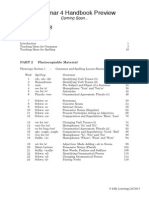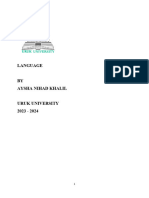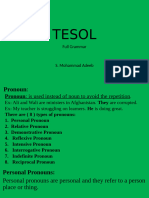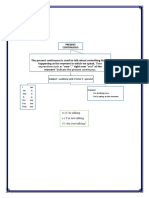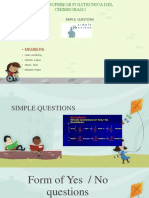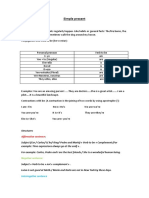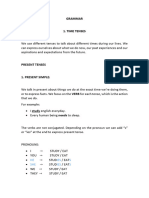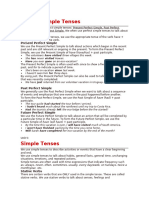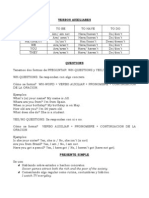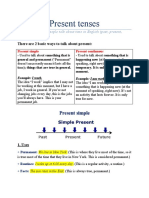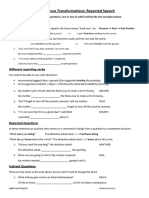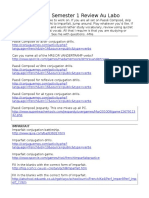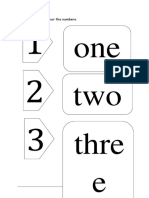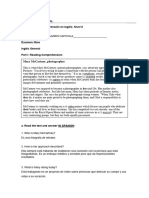Manual de Ingles
Manual de Ingles
Uploaded by
admonobradelaguardiaCopyright:
Available Formats
Manual de Ingles
Manual de Ingles
Uploaded by
admonobradelaguardiaOriginal Title
Copyright
Available Formats
Share this document
Did you find this document useful?
Is this content inappropriate?
Copyright:
Available Formats
Manual de Ingles
Manual de Ingles
Uploaded by
admonobradelaguardiaCopyright:
Available Formats
María Fernanda Cabello Martínez
SIMPLE PRESENT
Whe use the simple present to talk abaut habitual actions,
general truths and to express actions or situations tant occur
regulary in the present or that are permanent. We use it in
three ways: Afirmative, general truths; Negative, what we do
not do or is not true; Interrogative, asking about things that
usually happn or to abtain information.
This estructure is the next one:
AFIRMATIVE:
1- Select the subject.
SUBJECT SIGNIFICADO
I Yo
You Tu
She Ella
He El
It Eso- Animal o cosa
We Nosotros (as)
You Ustedes
They Ellos (as)
You must complement the sentence with:
Subject + Verb + Complement
She plays tennis every Saturday
He play tennis every Saturday
María Fernanda Cabello Martínez
2- Add the verb
When we use the subject I, You, We, They we conjugate
it as:
Subject + Verb + Complement
Example: I like cats
When we use the subjects He, She, It we will conjugate
the like:
Subject + Verb + s ies es + Complement
Example: She writes stories
How to do it?
It must be identified that if the verb ends in Y in the
previous letter it has a consunant or vowel.
When the verb ends in “y” and there is a consonant
before it, we change the “y” to “i” and add “es” to
have “ies” at the end.
Example: Try – Tries
When the verb ends in “y” and there is a vowel
beforeit, “s” is added.
Example: Stay – Stays
When the verb ends in s, o, sh, ch, h, x, z “es” is added.
Example: Miss – Misses… Go – Goes… Wish – Wishes…
Teach – Teaches… Brush – Brushes… Relax – Relaxes…
Quiz – Quizzes.
It the verb does not comply with these rules we only add
“s”.
Example: Open – Opens… Help – Helps… Visit – Visits…
Travel – Travels.
María Fernanda Cabello Martínez
NEGATIVE:
When we use the subjects I, You, We, They we use “do
not” (don`t).
Example: I don`t like pizza.
When we use the subject He, She, It we use “does not”
(doesn`t).
Example: She doesn`t eat fruit
We add the main verb in its base from after “do not” or
“does not”.
Example: We don`t drink coffe in the morning.
In the negative from, the main verb becomes its
negative form using “do not” or “does not” depending
on the subject pronoun, and the follows the main verb in
its base from.
INTERROGATIVE:
1- Select the question
SIGNIFICADO
Who Quién
Where Dónde
When Cuando
Why Por qué
What Qué/Cual
How Cómo
Which Cuál
How many Cuantos (contables)
How much Cuanto (no contable)
How often Qué tan seguido
María Fernanda Cabello Martínez
You must complete the question with:
Auxiliary verb + Person + Veb + Complement
Example: Do you play volleyball?
2- Add the question
When we use the subjects I, You, We, They is used “do”.
Example: Do you like hamburguer?
When we use the subjects He, She, It is used “does”.
Example: Does she eat fruit?
We place the subject after “do” or “does”.
Example: Do we drink coffe in the morning?
PRESENT CONTINUOUS
We use the present continuous to talk about actions that are
happening at the current momento, or for events that are
temporary. Its form using the verb “to be” in the present (am,
is, are) foolowed by the main verb with the ending –ing.
To talk abaut actions that constantly happen, You can
use adverbs like:
SIGNIFICADO
Always Siempre
Forever Para siempre
Constantly Constantemente
Often Muy seguido
Sometimes Algunas veces
Rarely Raramente/rara la vez
Neves Nunca
María Fernanda Cabello Martínez
AFIRMATIVE:
In the afirmative, the verb “to be” is used in the present
(am, is, are) followed by the main verb with the –ing
ending.
SIGNIFICADO
am soy
is es
are son
Rules of how to use –ing.
All verbs end in –ing.
It the verb ends in consonant + vowel + conconant we
add the last conconant + ing comply with the verbs that
have 1 “syllabe”.
Example: Dance – ing = Dancing
In the verb ends in “W, X, Y, Z” we do not repeat the
consonat.
Example: Snow – ing = Snowing
We the verbs ends in the letter “e” but it does not sound,
we just erase the latterand add –ing.
Example: Write – ing = Writing
When the verbs ends in “ie”, we change it for “Y” and
add –ing.
Example: Tie – Ty + ing = Tying
Its structure is the following:
Subject + Verb to be (am, is, are) + Verb (ing) + Complement.
Example: I am studying for my exam.
María Fernanda Cabello Martínez
NEGATIVE:
We use the present continuous negative to express
actions that are not happening at the present
moment or that are not in progress at the current
moment. We use it in the following way:
The verb "to be" in the negative form (am not, isn't,
aren't). After the verb "to be" in the negative form, add
the main verb in its base form (infinitive) + "-ing ".
Example: I am not playing football… She isn't studying right
now… They aren't watching TV.
Let's remember that the form of the verb "to be" in the
negative changes depending on the subject (am not for
"I", isn't for "he", "she”, "it", and aren't for "you", " we",
"they").
Its structure is the following:
Subject + Verb to be + not + Verb (ing) + Complement.
Example: It isn`t raining outside.
INTERROGATIVE:
We use the present continuous in an interrogative form to
ask about actions that are occurring at the present
moment or to obtain information about actions that are
in progress at the current moment.
The way to use it is as follows:
Decide who or what is the subject of the question.
Place the subject at the beginning of the interrogative
sentence.
María Fernanda Cabello Martínez
Use the verb "to be" in the correct form for the subject
(am, is, are). After the verb "to be" we place the main
verb in its basi (infinitive) + -"ing" form.
If necessary, we add the rest of the question (for
example, question words such as "What", "Where",
"When", "Why", "Who", etc).
Its structure is the following:
Verb to be + Subject + Verb (ing) + Complement + ?
Example: Are you cooking dinner tonight?
SIMPLE PAST
The simple past is used to describe completed actions or
situations that occurred at a specific time in the past. We use
"was" and "were" as past forms of the verb "to be" in English to
agree with subjects in number and person in the past. This
allows us to indicate that an action occurred in the past and
form the past simple accurately. Essentially, "was" is used with
singular subjects (I, he, she, it) and "were" is used with plural
subjects (you, we, you, them).
I You
Was (era) He Were (eran) We
She They
It
Example: I was happy yesterday.
María Fernanda Cabello Martínez
AFIRMATIVE:
We have to use "was" with singular pronouns like "I", "he",
"she", "it", as well as with singular nouns.
Example: She was happy.
Use "was" with singular nouns to indicate that something
or someone was in a specific state or position in the past.
Example: The cat was on the table.
Use "was" to describe actions or events that occurred in
the past for singular subjects.
Example: I was at the party last night.
Use "were" with the pronouns "you", "we", and "they" in
affirmative sentences in the simple past.
Example: We were at the beach yesterday.
Use "were" with plural nouns to describe actions or states
in the past that involve more than one entity.
Example: The children were playing in the park.
Its structure is the following:
😃 + Was/Were + Complement.
Example: It was a great concert last nigth.
NEGATIVE:
To use "was" in the negative, add "not" after "was":To form
the negation, add "not" after "was."The contracted form is
"wasn't" (for "was not").
Example: She was angry. / She wasn't angry.
María Fernanda Cabello Martínez
Do not change the main verb: The main verb remains in its
base form (infinitive) after "was not". Do not add "-ed" to
the main verb in the negative.
Example: He was not at home. / He wasn't at home.
Use "was not" with singular subjects such as "I", "he", "she",
"it", as well as with singular nouns.
Example: It was not a good idea.
To use "were" in the negative, add "not" after "were": To
form the negation, add "not" after "were."The contracted
form is "weren't" (for "were not").
Example: We were not at the party.
Do not change the main verb: The main verb remains in
its base form (infinitive) after "were not". Do not add "-ed"
to the main verb in the negative.
Example: We were not late. / We weren't late.
Sujeto plural:Utiliza "were not" con sujetos en plural como
"you", "we", "they", así como con nombres en plural.
Example: You were not happy with the result.
• Its structure is the following:
😃 + Was / Were + not + Complement.
Example: They weren 't playing soccer yesterday.
INTERROGATIVE:
Reverse the order of the subject and "was": Place "was"
at the beginning of the question, followed by the subject.
Add the rest of the question at the end: Complete the
question with the rest of the necessary structure (for
example, the complement).
María Fernanda Cabello Martínez
Use "was" with the pronouns "I", "he", "she", "it", as well as
with singular nouns.
Example: Was she at home yesterday?
Reverse the order of the subject and "were": Place "were"
at the beginning of the question, followed by the subject.
Add the rest of the question at the end: Complete the
question with the rest of the necessary structure (for
example, the complement).
Use "were" with the pronouns "you", "we , "they", as well as
with plural nouns.
Example: Were the children playing in the park?
Its structure is the following:
Was / Were + 😃 + Complement + ?
Example: Was Antonio at the library?
You might also like
- Jolly Phonics Grammar 4 Handbook PreviewDocument2 pagesJolly Phonics Grammar 4 Handbook Previewbookwormj56% (18)
- Tenses Finger Method Book by Dogar Brothers PDFDocument31 pagesTenses Finger Method Book by Dogar Brothers PDFnaeemakhtaracma62% (13)
- ESL - English as a Second Language - Verbs: a QuickStudy Digital Reference GuideFrom EverandESL - English as a Second Language - Verbs: a QuickStudy Digital Reference GuideNo ratings yet
- Adjective ClausesDocument9 pagesAdjective ClausessulastriNo ratings yet
- Các thì trong Tiếng AnhDocument15 pagesCác thì trong Tiếng AnhthuhanguyenproNo ratings yet
- Auxiliary VerbsDocument21 pagesAuxiliary VerbsyasameenaniNo ratings yet
- Remedial-Inglés Conversacional IDocument9 pagesRemedial-Inglés Conversacional IVictor RojasNo ratings yet
- Manual Lizbeth H FDocument18 pagesManual Lizbeth H Fapi-239674320No ratings yet
- Unidad 1Document23 pagesUnidad 1Deyvid Reto HNo ratings yet
- Unit Zero Octavo Enero 2020. Taller.Document14 pagesUnit Zero Octavo Enero 2020. Taller.Johana CamposNo ratings yet
- TESOL 1234 GrammarDocument196 pagesTESOL 1234 Grammarsafi.muslim01No ratings yet
- Present ContinuousDocument12 pagesPresent ContinuousCristian Ramirez RodasNo ratings yet
- University of Panama Vicepresidency of Research and Graduate Studies College of Humanities English DepartmentDocument28 pagesUniversity of Panama Vicepresidency of Research and Graduate Studies College of Humanities English DepartmentlingarajugowdaNo ratings yet
- Past Continuous Tense MaterialDocument5 pagesPast Continuous Tense MaterialgibranandzackconnorNo ratings yet
- Passive Voice_095413Document12 pagesPassive Voice_095413Júnior KatcherNo ratings yet
- InglesDocument19 pagesInglesBrian ShawNo ratings yet
- English Compendium 2Document16 pagesEnglish Compendium 2Erick Mendiola TorresNo ratings yet
- Approfondimenti Grammaticali Corso Inglese ECMDocument26 pagesApprofondimenti Grammaticali Corso Inglese ECMAntonio PiazzaNo ratings yet
- Present Simple PDFDocument5 pagesPresent Simple PDFMAITE CATALINA PONCE POBLETENo ratings yet
- Simple Present: InglêsDocument4 pagesSimple Present: Inglêsjurgute2000No ratings yet
- Simple QuestionsDocument52 pagesSimple QuestionsErica SaniNo ratings yet
- TRƯỜNG ĐẠI HỌC KIỂM SÁT HÀ NỘIDocument27 pagesTRƯỜNG ĐẠI HỌC KIỂM SÁT HÀ NỘIvuducngoc23No ratings yet
- Present Simple and Present Continuous & Present PerfectDocument4 pagesPresent Simple and Present Continuous & Present Perfectmararg2008No ratings yet
- Basic Tenses PresentationDocument14 pagesBasic Tenses PresentationDuvan JadyNo ratings yet
- Guía InglésDocument7 pagesGuía Inglésangelm.galicia.zNo ratings yet
- English Tenses: Written By: Faris Arifiansyah Class: Xi TKJ-B School: SMKN 1 CimahiDocument11 pagesEnglish Tenses: Written By: Faris Arifiansyah Class: Xi TKJ-B School: SMKN 1 CimahiFaris ArifiansyahNo ratings yet
- Basic InformationDocument44 pagesBasic InformationEDWIN PATRICK MCGUIRE OYOLANo ratings yet
- A Novel Idea Kamilan TakmilDocument77 pagesA Novel Idea Kamilan TakmilSofia RaheelNo ratings yet
- Complete English Grammar CourseDocument17 pagesComplete English Grammar Coursesaffatsifat9No ratings yet
- Home Work III Partial #1Document8 pagesHome Work III Partial #1Fertahis Rivers - MartinezNo ratings yet
- Introduce Yourself:: Thanks For Your AttentionDocument5 pagesIntroduce Yourself:: Thanks For Your Attentionkaterine mosqueraNo ratings yet
- How Do We Make The Simple Present Tense?Document24 pagesHow Do We Make The Simple Present Tense?Noelia Nancy PonceNo ratings yet
- Passive Voice + Different Time: MADE BY: Duran Daniela Pérez Andrés Pinos Erika Salcedo SebastiánDocument14 pagesPassive Voice + Different Time: MADE BY: Duran Daniela Pérez Andrés Pinos Erika Salcedo SebastiánDaniela DuranNo ratings yet
- Part # 1 Present Tense Present Simple TenseDocument9 pagesPart # 1 Present Tense Present Simple TensekhanNo ratings yet
- Would Present Simple Perfect Tenses Past SimpleDocument9 pagesWould Present Simple Perfect Tenses Past SimpleCesar A. GarciaNo ratings yet
- Tugas Bahasa Inggris "Rangkuman Dan Contoh": Disusun Oleh Nama: Candrika Della Vabelia Jurusan: 1 B KeperawatanDocument6 pagesTugas Bahasa Inggris "Rangkuman Dan Contoh": Disusun Oleh Nama: Candrika Della Vabelia Jurusan: 1 B KeperawatanJamilah p3No ratings yet
- The Present SimpleDocument2 pagesThe Present Simpleimadeddine799No ratings yet
- Tugas Summary 1-11Document17 pagesTugas Summary 1-11sherinaNo ratings yet
- ElementaryDocument9 pagesElementarybrifaniobumbaNo ratings yet
- Summary - Nadiah Oktarika 3Document8 pagesSummary - Nadiah Oktarika 3NadiahNo ratings yet
- Clase de InglesDocument17 pagesClase de InglesByron Bermello ToalaNo ratings yet
- Presentation EnglishDocument49 pagesPresentation EnglishribasdNo ratings yet
- VERBDocument13 pagesVERBseventhskyldhpbNo ratings yet
- Unidad 5Document7 pagesUnidad 5CarlosHernadezNo ratings yet
- Gramaticade InglesDocument10 pagesGramaticade InglesArianda Zarate ZarateNo ratings yet
- Simple Present TenseDocument7 pagesSimple Present TenseDaniel Giraldo CastroNo ratings yet
- Class 1Document6 pagesClass 1Pablo CuencaNo ratings yet
- English Lucturer: Saddam S. HmoodDocument12 pagesEnglish Lucturer: Saddam S. Hmoodاحمد حسين مجيد رستمNo ratings yet
- Tense PresentationDocument53 pagesTense PresentationProlificNo ratings yet
- Tenses ExplainDocument4 pagesTenses ExplaindedyNo ratings yet
- Grammar HandoutDocument10 pagesGrammar Handoutstonegrave68No ratings yet
- Simple Present - Present ProgressiveDocument11 pagesSimple Present - Present Progressivebenmehel abdelkrimNo ratings yet
- Perfect Simple TensesDocument2 pagesPerfect Simple Tensespaula.liutelchiNo ratings yet
- Simple PresentDocument10 pagesSimple PresentAndy CMNo ratings yet
- Verbos Auxiliares: Soccer Games Attract Both The Rich and The Poor of The Society. I Watch TV EverydayDocument3 pagesVerbos Auxiliares: Soccer Games Attract Both The Rich and The Poor of The Society. I Watch TV Everydaygeorgi_mgNo ratings yet
- Simple Present: InglêsDocument5 pagesSimple Present: InglêsHodžić NisvetaNo ratings yet
- Present Tenses: There Are 2 Basic Ways To Talk About PresentDocument13 pagesPresent Tenses: There Are 2 Basic Ways To Talk About PresentYujin IlNo ratings yet
- Present Simple Vs Present ContinuosDocument2 pagesPresent Simple Vs Present ContinuosHuevito con CatsupNo ratings yet
- SO Is Used To Show Agreement With Positive Statements. SO + Auxiliary/Be + Subject (Pronoun)Document5 pagesSO Is Used To Show Agreement With Positive Statements. SO + Auxiliary/Be + Subject (Pronoun)Muhammad Azri MaulanaNo ratings yet
- Genesis Paguay Student S Portfolio NRC4071.Document22 pagesGenesis Paguay Student S Portfolio NRC4071.erick izaNo ratings yet
- Adverbs Notes 1Document6 pagesAdverbs Notes 1JULIE ANNE A/P BARNAT MoeNo ratings yet
- English for Execs: And Everyone Who Desires to Use Good English and Speak English Well!From EverandEnglish for Execs: And Everyone Who Desires to Use Good English and Speak English Well!No ratings yet
- Rules of Word Stress in English: 1 Stress On First Syllable Rule ExampleDocument5 pagesRules of Word Stress in English: 1 Stress On First Syllable Rule ExampleNinuk Retna SumiarsihNo ratings yet
- Articles: Articles Are Words That Define A Noun As Specific or UnspecificDocument12 pagesArticles: Articles Are Words That Define A Noun As Specific or UnspecificArya Dharma ChandraNo ratings yet
- Big Surprise 3 English Test Unit FourDocument3 pagesBig Surprise 3 English Test Unit FourAnonymous HxAcjKYT100% (1)
- Task #8 Tarquino MauricioDocument2 pagesTask #8 Tarquino MauricioMauricio Tarquino FloresNo ratings yet
- Modul Short Course Pusbamulya 2021Document51 pagesModul Short Course Pusbamulya 2021HRP. PardedeNo ratings yet
- Noam Chomsky - Morphophonemics of Modern HebrewDocument82 pagesNoam Chomsky - Morphophonemics of Modern Hebrewdeco070No ratings yet
- Planeación Didactica: Games/school-SubjectsDocument6 pagesPlaneación Didactica: Games/school-SubjectsLorena Vega LimonNo ratings yet
- St. Mary's Sr. Sec. School, Jwalapur: SyllabusDocument5 pagesSt. Mary's Sr. Sec. School, Jwalapur: SyllabusAbhinavGargNo ratings yet
- Some, AnyDocument24 pagesSome, AnyEmilija Jovanovic0% (2)
- Giovanni Molino's Dittionario Della Lingua Italiana, Turchesca (1641) - by Ewa Siemieniec-GołaśDocument22 pagesGiovanni Molino's Dittionario Della Lingua Italiana, Turchesca (1641) - by Ewa Siemieniec-GołaśTurcology TiranaNo ratings yet
- FCE Sentence Transformations With Reported SpeechDocument1 pageFCE Sentence Transformations With Reported SpeechMercedes GaviñoNo ratings yet
- Latihan PRONOUNDocument2 pagesLatihan PRONOUNYuanita Maya DamayantiNo ratings yet
- Basic Nouns Verbs AdjectivesDocument2 pagesBasic Nouns Verbs AdjectivesEduardo DamascenoNo ratings yet
- French 3 Semester 1 Review Au LaboDocument4 pagesFrench 3 Semester 1 Review Au Laboapi-290605652No ratings yet
- Possessive PronounDocument2 pagesPossessive PronounRiandi HartartoNo ratings yet
- Tracing Numbers in WordsDocument37 pagesTracing Numbers in WordsNur ZahidNo ratings yet
- BohairicDocument18 pagesBohairicJosé Ribeiro NetoNo ratings yet
- ACL 2011 Zero To Greek WorkshopDocument45 pagesACL 2011 Zero To Greek Workshopviolante28100% (2)
- Reflexive PronounDocument9 pagesReflexive PronounchikomoggerNo ratings yet
- Nouns Singular and Plural Grammar Guides Picture Dictionaries - 38791Document1 pageNouns Singular and Plural Grammar Guides Picture Dictionaries - 38791Ming Er SioeNo ratings yet
- Pronoun Antecedent Agreement Complete PacketDocument6 pagesPronoun Antecedent Agreement Complete PacketpoohlNo ratings yet
- UTS BK B (Daniel OsvaldoDocument4 pagesUTS BK B (Daniel OsvaldoPemersatu BangsaNo ratings yet
- 2023 Examen Libre Gral. Nivel 2 HechoDocument3 pages2023 Examen Libre Gral. Nivel 2 HechojazminNo ratings yet
- What's The News Today?: Pathway To English For Senior High School Grade XII General ProgramDocument22 pagesWhat's The News Today?: Pathway To English For Senior High School Grade XII General ProgramMaulana Surya NegaraNo ratings yet
- Lectio Decima Septima: de Ablativo AbsoluteDocument10 pagesLectio Decima Septima: de Ablativo AbsoluteDomina Nostra FatimaNo ratings yet
- Units 16 19 Grammar ExercisesDocument5 pagesUnits 16 19 Grammar ExercisescabricaNo ratings yet
- Irregular Verbs ListDocument5 pagesIrregular Verbs Listwallllou100% (1)
- Soal Ujian Tengah SemesterDocument2 pagesSoal Ujian Tengah SemesterOrigami lipatNo ratings yet
